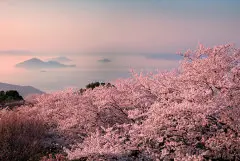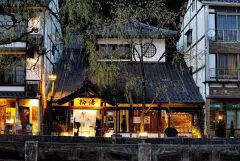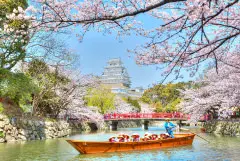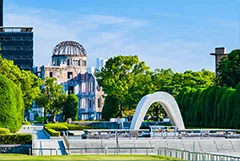Art & Culture
Carrying On the Art of Indigo Dyeing in Tokushima

-
- DESTINATION NAME
- Tokushima
-
- RELATED TAGS
-
- LAST UPDATED
- 19 April, 2021
Here in Tokushima, surrounded by the calm blue Seto Inland Sea, a tradition of artisanal indigo dyeing known as aizome lives on. It makes perfect sense that here, with the hues of the sea and the skies above it constantly shifting in infinite shades of blue throughout the year, creating art with this simple blue dye is held in such high regard.
Preserving the Natural Indigo Dyeing Tradition in Tokushima
Natural indigo dyeing was popularized throughout Japan around the 17th century to create clothing and household items. Cloth dyed with indigo is naturally insect repellant and antibacterial, which led to its popularity among the common people. When Japan opened its doors to the world in the Meiji Period starting around 1868, cheaper chemical-based indigo dyes imported from Germany enabled indigo cloth manufacturers to dramatically increase production. While a boon to both consumers and large-scale manufacturers, this change from natural to chemical-based dyes effectively spelled the end for hundreds of natural indigo dyers around Japan.
Today, indigo dyers maintain this production method as an art form rather than an industry. Tokushima is the largest city in Japan for natural indigo dyeing and one of the only areas left where indigo is still cultivated and processed into sukumo, the material required to make the dye. Many talented indigo artists make their home in Tokushima, including Chiaki Murakami and her apprentice, Lin Yuling, of the indigo dyeing shop and atelier Aiyakazou.
A Long History of Indigo Dyeing and Commerce at Aiyakazou
Aiyakazou was founded by the Okamura family, merchants who began selling sukumo in the early 1800s. Across the street from the shop and studio, the old Okumura house and sukumo processing building have been donated to the local government as an indigo dyeing museum. 90% of the items on sale at Aiyakazou are made using the natural indigo dyeing process, some of which are intricate works of art dyed from a single color known as “Awa Ai”, Tokushima indigo.
Murakami and Lin walked me through the process of dyeing a simple handkerchief with a pattern created by preventing certain areas of the cloth from being in contact with the dye using objects such as wooden blocks or rubber bands. Surprisingly, the dye is not blue in color but a brownish-green. Lin explained that contact with oxygen turns the dye blue, which is why the vats need to be handled gently to keep the liquid from oxygenating faster than necessary.
With that word of warning, I daintily swished my handkerchief around in the dye, wearing long rubber gloves. The artists laughed at my timid clumsiness and eventually took over, their forever blue-dyed hands plunging the cloth deep into the vat. While we worked, we chatted about how natural indigo dyeing was making a comeback in recent years, spurred by young people who are gaining an interest in Japan’s natural traditions and processes. Young people from Japan and around the world are coming to Tokushima to learn both dyeing and sukumo production techniques. A mere five companies now produce all the sukumo in Japan here in Tokushima, so there is a dire need for a new generation to learn the trade to keep this tradition alive.
Murakami herself came back to her home in Tokushima as a young woman to learn indigo dyeing as an art. Before returning, she worked in Kyoto as a yuzen dyer, a style of dyeing commonly used in the production of high-end kimono and obi. When demand for those items slowed, she decided to try her hand with aikome. Over 30 years later, Murakami is still practicing her art and sharing her experience with young students like Lin. Her work displays a feminine side of indigo, which is traditionally known as a masculine color.
Finally, with the dyeing completed, we took my handkerchief to the washbasin. The oxygen in the water transformed the greenish dye into brilliant “Awa Ai” before my eyes. Much like the art form itself here in Tokushima, with care, the dyed cloth will last for years, becoming only the more brilliant over time.
How to Get to Aiyakazou
Aiyakazou is located in the western part of Tokushima city. A rental car is the easiest way to access it, and you can also use the car to explore other parts of Tokushima, such as the Iya Valley and Oboke Gorge, or visit the zero waste town of Kamikatsu.
From Tokyo, the easiest way to get to Tokushima is a domestic flight from Haneda to Tokushima Awaodori Airport, which takes about 90 minutes. From Osaka or Kyoto, take the Shinkansen bullet train to Okayama (about 60 to 90 minutes) and drive to Tokushima (about 2 hours).
At the time of this writing, workshops at Aiyakazou are held only infrequently and irregularly. According to Murakami, there are plans to organize regular workshops in the future; however, it is best to consult with the shop before making plans. The shop displays and sells a large variety of naturally dyed indigo products and other goods and is open from 9:30 to 17:00 daily.
Photographs and text by Todd Fong
RELATED DESTINATION
Tokushima
It has lots of tourism resources including the Naruto Strait, which has one of the largest eddying currents in the world, and the Iya Valley, which captivates everyone who sees its overwhelming natural scenery. The traditional Awa Dance Festival, which teems with 1.3 million tourists, is a must-see.














































